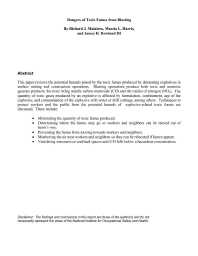Mining Publication: Dangers of Toxic Fumes from Blasting
Original creation date: January 2007
This paper reviews the potential hazards posed by the toxic fumes produced by detonating explosives in surface mining and construction operations. Blasting operations produce both toxic and nontoxic gaseous products; the toxic being mainly carbon monoxide (CO) and the oxides of nitrogen (NOx). The quantity of toxic gases produced by an explosive is affected by formulation, confinement, age of the explosive, and contamination of the explosive with water or drill cuttings, among others. Techniques to protect workers and the public from the potential hazards of explosive-related toxic fumes are discussed. These include: 1. Minimizing the quantity of toxic fumes produced. 2. Determining where the fumes may go so workers and neighbors can be moved out of harm's way. 3. Preventing the fumes from moving towards workers and neighbors. 4. Monitoring the air near workers and neighbors so they can be relocated if fumes appear. 5. Ventilating structures or confined spaces until CO falls below a hazardous concentration.
Authors: RJ Mainiero, ML Harris, JH Rowland
Conference Paper - January 2007
NIOSHTIC2 Number: 20032444
Proceedings of the 33rd Annual Conference on Explosives and Blasting Technique, Nashville, TN, January 28-31, 2007. Cleveland, OH: International Society of Explosives Engineers, 2007; 1: 1-6
See Also
- Chemical and Physical Factors that Influence N0x Production During Blasting: Exploratory Study
- Factors Affecting ANFO Fumes Production
- Factors Affecting Fumes Production of an Emulsion and ANFO/Emulsion Blends
- Field Studies of CO Migration from Blasting
- Fugitive Carbon-Based Gases: Blasting Related or Not
- Monitoring and Removal of CO in Blasting Operations
- A Technique for Measuring Toxic Gases Produced by Blasting Agents
- Technology News 522 - Blast Area Security: Flyrock Safety
- Toolbox Training on Flyrock Awareness
- Toxic Fume Comparison of a Few Explosives Used in Trench Blasting
- Page last reviewed: 9/21/2012
- Page last updated: 9/21/2012
- Content source: National Institute for Occupational Safety and Health, Mining Program


 ShareCompartir
ShareCompartir
